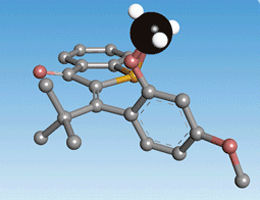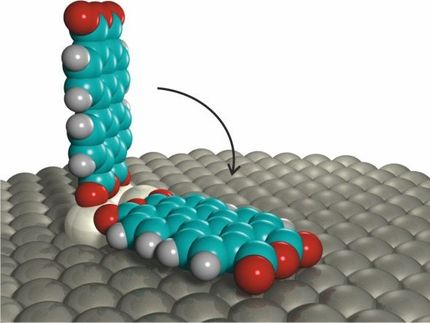Molecular motors: Chemical carousel rotates in the cold
LMU chemists have developed the first molecular motor that can be powered by light alone. Its operation is therefore essentially independent of the temperature.

The new molecular motor requires only three light-driven reaction steps to achieve complete rotation.
A. Gerwien, LMU
Molecular motors, which rotate unidirectionally in response to an external energy input, constitute an important class of components for future applications in the field of nanotechnology. Molecules whose structure and spatial conformation can be altered by light are particularly promising candidates for this task. However, all light-driven molecular motors so far described are dependent on reactions that require the input of heat and are therefore dependent on a certain minimum environmental temperature. LMU chemist Henry Dube has now achieved a decisive breakthrough in this respect. Together with his student Aaron Gerwien, he has developed the first molecular motor that rotates on exposure to light alone, irrespective of the temperature. Not only is its operation not conditional on a specific minimum temperature – it actually rotates faster at lower temperatures. This unique characteristic of the new molecule could significantly extend the range of applications available to future nanomachines.
The essential property that turns a synthetic chemical into a molecular rotary motor is that an external energy source can cause some component of the molecule to rotate unidirectionally. Each 360° rotation takes place in discrete steps like the ticking of a clock hand. The tricky part is to ensure that each forward step does not go into reverse. All of the molecular motors so far described have used what is called a ratchet mechanism to prevent such reversals. The idea is that after each forward step a ratcheting step alters the configuration of the molecule in such a way that the reverse reaction is sterically inhibited. The conformational changes necessary to achieve this are normally induced by heat. As a result, the rate of rotation is dependent on the ambient temperature, and below a certain minimum temperature the movement ceases.
Like earlier motor systems developed by Dube and his colleagues, the new motor is based on an organic substance called hemithioindigo. This molecule is made up of two different carbon skeletons, which are connected by a mobile double bond. “We have succeeded in modifying the molecule such that a complete rotation of one of the structural modules relative to the other requires only three reaction steps,” says Dube. Each rotational step is activated by visible light and there is no need for intermediate, thermally driven ratchet steps. Indeed, all three steps involved in the full rotation are promoted by a reduction in temperature, so that the rotation rate of the new molecules actually increases at lower temperatures. “Each rotation step is made up of three different photoreactions, two of which we experimentally demonstrated directly for the first time only this year,” Dube explains. The researchers are confident that their motor’s novel driving mechanism and unique behavior will make it possible in the not too distant future for researchers to synthesize molecular machines which, thanks to their relative insensitivity to the precise environmental temperature, will enable unique applications not possible with hitherto known motors.
Original publication
Other news from the department science

Get the chemical industry in your inbox
By submitting this form you agree that LUMITOS AG will send you the newsletter(s) selected above by email. Your data will not be passed on to third parties. Your data will be stored and processed in accordance with our data protection regulations. LUMITOS may contact you by email for the purpose of advertising or market and opinion surveys. You can revoke your consent at any time without giving reasons to LUMITOS AG, Ernst-Augustin-Str. 2, 12489 Berlin, Germany or by e-mail at revoke@lumitos.com with effect for the future. In addition, each email contains a link to unsubscribe from the corresponding newsletter.



























































